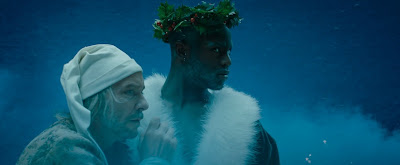Title:
A Christmas Carol
Format:
Live action feature film
Country:
UK
Production company:
Frith Street Films
Year:
2020
Length:
96 minutes
Setting:
Fantasy Victorian
Background:
This is, I feel reasonably certain of saying, a unique version of the Carol. There is a framing set-up at the start and end which is conventionally acted and performed, of some children putting on a kind of puppet show version of the Carol with cut-out paper figures from newspapers and illustrations, for an audience of presumably their mother and father and a younger sibling. An older woman, perhaps their grandmother, narrates.
But the main action of the story and the majority of the
film takes place ‘within’ their model theatre stage. Live-action performances
among dioramas of cut-out newspaper clippings and Leech-like illustrations and
cardboard walls. And these live-action performers do not speak any words – they
glide and move but all the vocal performances are given by others, mixed with
the narration. The whole effect is rather like watching a narrated ballet with
voiceovers for the different characters, or visuals put to a radio play.
A Christmas Carol
Live action feature film
UK
Frith Street Films
2020
96 minutes
Fantasy Victorian
This is, I feel reasonably certain of saying, a unique version of the Carol. There is a framing set-up at the start and end which is conventionally acted and performed, of some children putting on a kind of puppet show version of the Carol with cut-out paper figures from newspapers and illustrations, for an audience of presumably their mother and father and a younger sibling. An older woman, perhaps their grandmother, narrates.
Each of the characters, outside of the framing set-up, has two performers – a dancer and a voice artist. So, for example, Scrooge is seen being performed on-screen as a dancer by Michael Nunn, but all of his dialogue is delivered by Simon Russell Beale, as Nunn’s lips never move to it, nor do any of the other characters to their voice actors – this is not a mime show.
The film is directed by Northampton-born brother-and-sister
team Jacqui and David Morris, with David providing the screenplay. They began
their filmmaking career on documentaries, being BAFTA nominated for their
production about war photographer Don McCullin. Together they run Frith Street Films, which was the production company for this version of the Carol.
Having Phillips as the narrator means that, much like Gonzo in the Muppet version, we get to keep much of Dickens’ prose from the book which would otherwise have been lost in a more conventional screen adaptation, so that’s a good move. However, there is one change near the very start which gives me pause. The underlining that it must be understood that Marley is dead at the start “…or nothing wonderful can come of the story I am going to relate,” is here changed to “nothing good,” which I’d suggest is a rather different thing.
The spirit is female on this occasion, and seems to lack any of the candle imagery specified by Dickens – although I suppose you could say that her dance performance is perhaps intended to evoke the flickering of a flame. It’s fairly subtle though, if so, which isn’t necessarily a bad thing, of course.
Most of the usual main elements are all present and correct here, but as in other places they also include some things which other adaptations often omit. So we have Scrooge’s confrontation with the spirit over the pressure to close bakeries on Sundays, and a little of their trip out to sea – although no miners.
Just before the end of the section, there is another of
the inventions unique to this version, as we see examples of violence,
aggression and prostitution on the streets of Victorian London. These are
seemingly there to underline the issues of Ignorance and Want, as unveiled from
beneath the spirit’s cloak as in the original.
Yet-to-Come:
The spirit has something of its usual hooded shape, but taking a cue from Dickens’s description of it “coming like a mist along the ground,” it’s depicted here not so much as a person as a kind of black cloud with a single hand emerging from it to point and gesture as-and-when required.
The spirit has something of its usual hooded shape, but taking a cue from Dickens’s description of it “coming like a mist along the ground,” it’s depicted here not so much as a person as a kind of black cloud with a single hand emerging from it to point and gesture as-and-when required.
What’s To-Day:
Again, very faithful to the book – although there is one
oddity which I don’t quite understand. When Scrooge asks the boy below his
window to go and buy the prize bird from the poulterers’ for him, Dickens has
the boy reply with a disbelieving “Walk-er!” This no longer being a
common expression it’s not usually included in adaptations, although it is
sometimes by those who like the period flavour it gives or just want to try and
be as authentic to the text as they can.Review:
It’s hard not to imagine a lot of the people who might
actually have ventured to the cinema to see this turning to someone who’d come
to it with them a little way in and asking, in trepidation, “Is it… like this
all the way through?”There are far worse versions, and it is an interesting experiment. It looks lovely – but I find it hard to believe it could ever be anybody’s favourite version of the Carol.







